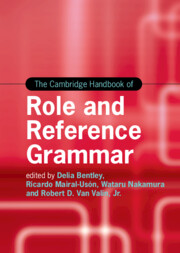Book contents
- The Cambridge Handbook of Role and Reference Grammar
- Cambridge Handbooks in Language and Linguistics
- The Cambridge Handbook of Role and Reference Grammar
- Copyright page
- Dedication
- Contents
- Figures
- Tables
- Contributors
- Pedagogical Guide to The Cambridge Handbook of Role and Reference Grammar
- Introduction
- Part One Overview
- Part Two Topics in RRG: Simple Sentences
- Part Three Topics in RRG: Complex Sentences
- Part Four Applications of RRG
- Part Five Grammatical Sketches
- 22 A Grammatical Sketch of Cheyenne (Plains Algonquian, USA)
- 23 A Grammatical Sketch of Yimas (Lower Sepik, Papua New Guinea)
- 24 A Grammatical Sketch of Avatime (Kwa, Niger-Congo, Ghana)
- 25 A Grammatical Sketch of Amele (Papuan, Papua New Guinea)
- 26 Case and Voice in Amis (Austronesian, Taiwan)
- Index
- References
24 - A Grammatical Sketch of Avatime (Kwa, Niger-Congo, Ghana)
from Part Five - Grammatical Sketches
Published online by Cambridge University Press: 08 June 2023
- The Cambridge Handbook of Role and Reference Grammar
- Cambridge Handbooks in Language and Linguistics
- The Cambridge Handbook of Role and Reference Grammar
- Copyright page
- Dedication
- Contents
- Figures
- Tables
- Contributors
- Pedagogical Guide to The Cambridge Handbook of Role and Reference Grammar
- Introduction
- Part One Overview
- Part Two Topics in RRG: Simple Sentences
- Part Three Topics in RRG: Complex Sentences
- Part Four Applications of RRG
- Part Five Grammatical Sketches
- 22 A Grammatical Sketch of Cheyenne (Plains Algonquian, USA)
- 23 A Grammatical Sketch of Yimas (Lower Sepik, Papua New Guinea)
- 24 A Grammatical Sketch of Avatime (Kwa, Niger-Congo, Ghana)
- 25 A Grammatical Sketch of Amele (Papuan, Papua New Guinea)
- 26 Case and Voice in Amis (Austronesian, Taiwan)
- Index
- References
Summary
This chapter provides a grammatical overview of Avatime, a Niger-Congo language spoken in the south-east of Ghana. The first part surveys lexical categories (parts of speech and major Aktionsart classes of predicates), syntactic structure (clause structure, grammatical operators, nominal structure, and adpositional structure), and focus structure, while the second part is devoted to describing and illustrating the rich variety of serial verb constructions in Avatime, identifying three types of juncture–nexus (nuclear cosubordination, core coordination, and core cosubordination), and investigating how the correspondences of these juncture–nexus relations and their semantic functions fit into the Interclausal Relations Hierarchy.
- Type
- Chapter
- Information
- The Cambridge Handbook of Role and Reference Grammar , pp. 889 - 913Publisher: Cambridge University PressPrint publication year: 2023



